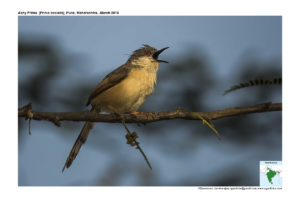Ashy Prinia

Ashy Prinia Prinia socialis
Etymology:
- Prinia : Javanese name Prinyafor the Prinia
- Socialis: Latin word for sociable derived from sociare – to associate
Vernacular Names :Hindi: Phutki, Kali phutki, Pun: Asmanipiddi, Guj: Kali pan fudki, Rakhodifadakfutki, Mar: Rakhivatvatya, Ta: Tinu-kuruvi, Te: Budidarangu pitta, Mal: Katirkuruvi, Sinh: Hambu-kurulla
Distribution in India: Resident across India except for some parts of North West
Description: Size of 12-13 cm. In breeding plumage, upperparts are purer ashy grey, Supercilium disappears, and tail is a little shorter and less graduated; bill and interior of mouth black, eyes ruby-red. The Non-breeding plumage has dusky lores, paling over ear-coverts, bordered above by narrow white or buff-white short Supercilium (not extending behind eye); top of head (down to malar), upper ear-coverts, nape, mantle, back and scapulars ashy grey, back faintly washed rufous, rump and upper tail-coverts grey-brown; upper wing ashy grey, rufous edges of flight-feathers and tertials (forms rusty wing panel); tail rufous brown, the outer feathers with an indistinct dark sub terminal mark and tips only a little paler; strongly washed warm rufous-buff below, becoming paler on throat; iris brownish-yellow to orange-brown; upper mandible horn-brown, lower mandible and mouth are flesh-coloured; legs flesh-coloured. Both the sexes are similar. Both the sexes are similar.
Habitat: It is found in bushy places, from scrubby grassland to garden shrubbery, including Lantana thickets, mangrove swamps, reed beds, and bushy edges of cultivation and tea plantations. Also forest edge and secondary growth, and bracken-covered hillsides Seen up to 1200 meters in Himalayas
Food Habits: It eats small invertebrates, chiefly insects and their larvae, and small spiders, also eats flower nectar. It is found singly or in pairs. Although not shy, is generally unobtrusive, keeping low in vegetation. It forages by climbing up stalks or inside bushes, gleaning insects from both leaves and ground.
Breeding Habits: They breed in May- Aug. Nest built by both sexes, in 6–8 days. Nest is of three types, the most frequent an oblong-shaped bag made from woven grass and stems, built around supporting grass stems; the most remarkable one is constructed inside two or three leaves which have been stitched together or is sewn on to side of one large leaf, up to 200 stitches used to join leaves; the third type is a flimsily built ball of grasses, supported by stems and weeds, with neater central cup of fine grasses; nest generally placed within 60 cm of ground in dense bush, usually not far from a water source; same pair will build more than one type of nest. They lay a clutch 3–5 eggs; incubation by both sexes, for 11–12 days; chicks brooded closely for first 2–3 days by female, fed at nest by male. Nests are parasitized by Plaintive Cuckoo. The nest is also prone to predation by snakes, Coucal, and Lizards. While building the nest is robbed by Oriental White-eye for building material.The nest is also affected by heavy rain and wind. That is why replacement clutch is laid after failure, there might be up to six re-layings per season